
|
|

February 6, 2009
Boston's WCVB and WHDH-TV/WLVI
So here we are at a most exciting moment in broadcast history, just a few weeks away from the end of full-power analog TV...wait, what's that again? Oh, right...here we are at a most exciting moment in broadcast history, just a few months away from the official end of full-power analog TV broadcasting in the US, unless, of course, you live in one of the many markets where sensible broadcasters are going ahead and pulling the plug Feb. 17 in spite of Congress' well-meaning but utterly confusing attempt to "help" the transition along. In any event, we'll continue our look at historic analog sites for a few more weeks here on Site of the Week, including these pictures taken just last week during a swing around New England...)
It's funny how familiarity breeds, if not contempt, then at least a certain laziness.
Having lived in the Boston suburbs, almost within view of the Needham/Newton tower farm, for many years, your editor could always think there'd be another chance, sometime later on, to finally get inside all those Boston TV transmitter buildings we'd never seen.
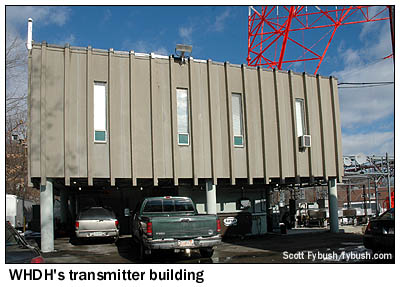 |
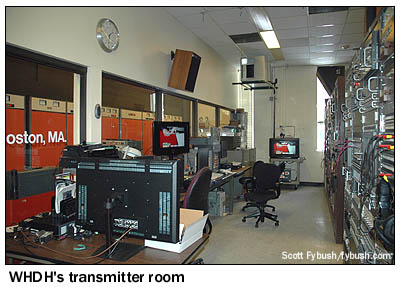 |
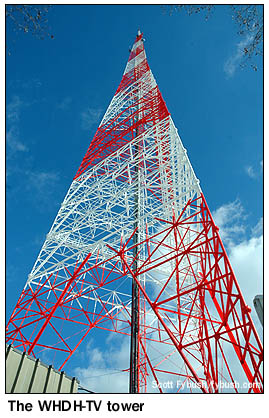 But
then came the impending DTV transition, and all of a sudden time
was fast running out on any opportunity to see those analog transmitters
we'd been watching all those years ago.
But
then came the impending DTV transition, and all of a sudden time
was fast running out on any opportunity to see those analog transmitters
we'd been watching all those years ago.
So on a chilly winter's day in late January 2009, just weeks before the scheduled analog shutoff, we ventured east to catch up.
One of the most distinctive sites we'd never seen is the WHDH-TV (Channel 7) tower, the tallest self-supporting tower in New England and, at 1062', one of the tallest anywhere in the country.
Channel 7 was WNAC-TV, one of the flagships of RKO Broadcasting, when this tower went up in 1963. WNAC-TV was one of Boston's oldest TV stations, but its longtime transmitter site on the Malden/Medford line, north of Boston, had ended up at a disadvantage after first WBZ-TV (Channel 4) and then WHDH-TV (Channel 5) had built tall towers west of Boston in Needham and Newton, respectively.
Not wanting to lose out on the additional coverage of the Worcester area and western suburbs provided by the Newton/Needham sites, WNAC followed WBZ and WHDH west, building a state-of-the-art facility on a site just north of Needham Street, which had not yet become the busy commercial strip it is today.
The new site boasted the first-ever installation of two RCA TV transmitters fed through a combiner to generate 50 kW total power output. Back then, the transmitters faced out into a big open room, where there was always at least one transmitter operator on duty (and we'd bet he's wearing a tie along with that short-sleeve shirt!)
WNAC-FM (98.5) was here back then, too, and while the picture (from an RCA equipment catalog, circa 1964) doesn't show it, the FM transmitter was probably somewhere behind the engineer.
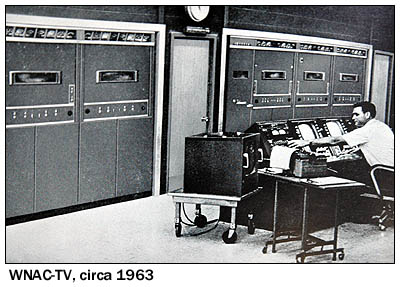 |
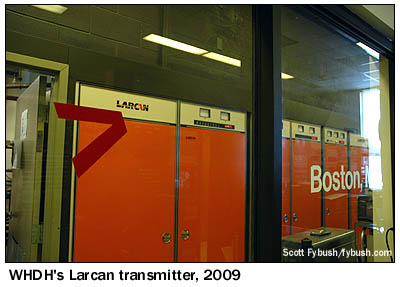 |
Today, the site is a little more crowded. The FM is gone, having left this site in the early eighties when RKO was forced out of broadcast ownership and its radio and TV holdings went to separate owners. The FM became WROR, and later WBMX, and now uses the "FM-128" tower, the former WHDH-TV 5, a mile or so away. Channel 7 went to supermarket entrepreneur David Mugar, becoming WNEV in 1982, then - ironically - WHDH-TV a decade later. Not long after the call change, Mugar sold Channel 7 to Miami's Ed Ansin, who still owns it today.
Relics of the WNEV era, and even its distinctive "SE7EN" logo, still abound at the site. Downstairs, there are several utilitarian rooms handling the site's incoming AC power and housing big generators. The transmitters are all upstairs, where a stairwell opens up into several small rooms - one an office, with files dating back to this site's early years, another (which I think once held WNAC-FM) housing the temporary WHDH-DT (Channel 42) setup.
Those rooms look out into the big room seen in that 1964 photo, though the spot where the engineer sat at his console was eventually replaced by a glass wall separating the engineers from newer transmitters. That distinctively orange Larcan was the first VHF transmitter the Canadian company sold in the US, back in 1984, and it was still going strong when we visited a quarter-century later, occupying barely half the space that old RCA TT-50DH took up.
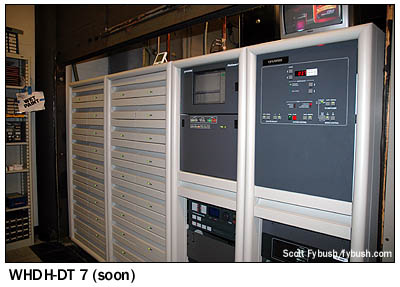 |
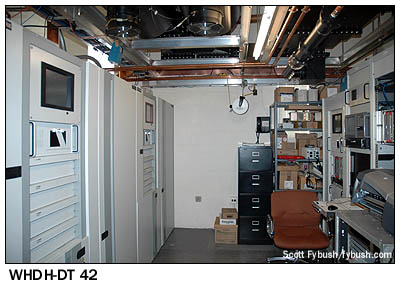 |
To the left of the Larcan is a Harris Platinum solid-state transmitter, which has been running as a backup to the Larcan until it assumes its new permanent duty as the main transmitter of WHDH-DT's new Channel 7 operation. What will become of the UHF transmitter in the back room? It'll probably be sold - but eventually, this site will be used to back up the sister station Ansin bought a couple of years ago, CW affiliate WLVI (Channel 56).
WLVI's main site is less than a mile away, down Needham Street/Highland Avenue and across the Charles River in Needham, at the big candelabra tower that went up in 1971 on the hill where the Needham Sheraton hotel would soon be built. Channel 56 was then WKBG, a partnership of Kaiser Broadcasting and the Boston Globe, and it moved from its original site on Zion Hill in Woburn to a utilitarian block building at the tower's base.
It's still there today, with a big Comark analog transmitter for channel 56 across from a Thomson DTV transmitter for WLVI-DT 41, which will stay on the air after the Comark gets shut off...whenever.
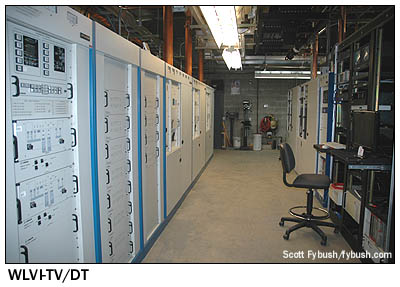 |
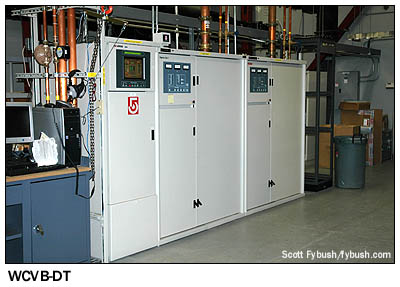 |
A little later in the day, we make it over to the other Needham transmitter site, the one built in 1957 by WBZ-TV. When the original channel 5, WHDH-TV, lost its license in 1972, the old licensee wouldn't sell the WHDH-TV facilities to the new channel 5, WCVB. So WCVB ended up leasing space from WBZ at its Needham site, building a small brick transmitter building next to the original channel 4 building. The original WCVB transmitter was a Norelco, but it eventually gave way to the RCA G-line transmitter that now sits as an unused auxiliary across from the Larcan that's been the channel 5 analog transmitter for the last few years.
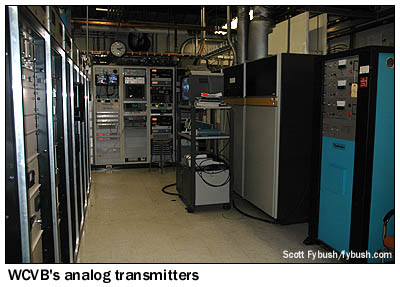 |
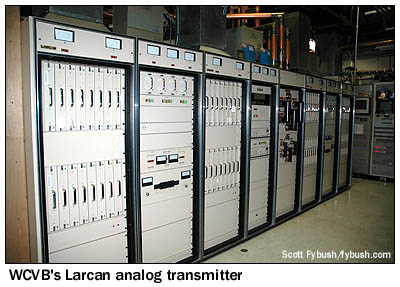 |
WCVB-DT (Channel 20) was Boston's first digital TV station, more than a decade ago already (!), and today WCVB-DT occupies one row of the huge new DTV building that we profiled back in 2004 on Site of the Week, running a Harris transmitter substantially identical to that of its neighbor, WBZ-DT (Channel 30).
What will become of the analog building when Channel 5 falls silent soon after more than half a century? That decision hasn't been made yet, we're told...but now at least we can say we saw it when it was still active.
- Previous Site of the Week: Empire State Building, New York
- Next Week: TBA
- Site of the Week INDEX!
- How can you help support Site of the Week? Click here!
- Submit your suggestions for a future Site of the Week!
